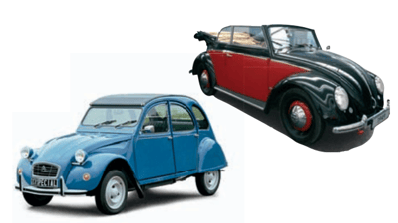Precious metal: Classic cars promise high returns. Not Always a safe bet. The competence center classic cars reveals what is behind the chrome and metal.

More and more people are enjoying classic cars. They are fascinated by their technology, but also by their monetary value: The returns can be seductively high. But it is important to be careful when investing in classic cars.
Large amounts quickly come into play, both for the purchase price and the maintenance, not to mention restoration. But it is not just expensive luxury vehicles which bring high returns – the ‘workers’ cars’ from back then, such as the Citroen 2 CV, Renault R4, Fiat 500 or VW Beetle, do too, and they are still affordable even today. That is why this market has grown so significantly over recent years, both for good-value mass-produced cars and for expensive one-offs.
But when is a vehicle worth holding on to? What is a real classic car and what is just scrap metal? Where is the line between good and bad, between patina and decay?
TÜV Rheinland has now founded the Competence Center Classic Cars in order to answer these and other questions with expertise. Its Managing Director is surveyor Norbert Schroeder: “Essentially, a restoration can cost a lot if you don’t know what you’re doing. There are clear requirements for what counts as a classic car after restoration,” he reports.
Dangers lurk in rust, defects which have been covered up and high repair costs, ad well as in the work of counterfeiters. One extreme case experienced by Norbert Schroeder came in the form of a perfectly maintained BMW. The real classic car could have fetched half a million euros on the market, but two welded seams revealed it as a replica. Thanks to the truly excellent craftsmanship, it is still valued at EUR 100,000, but is classed as a new car.
“Only really experienced surveyors can help here. A layman would never have noticed. “It’s a business which really pays off for counterfeiters, as the sales revenue is many times the investment put in,” says Schroeder.
Although these are exceptions, this field is certainly one for experts. Anyone who is not an expert definitely needs to seek advice. Otherwise, their dream of eternal youth in clear lacquer can quickly rust away before their very eyes, and a great deal can become a bottomless pit of costs.
“There are actually two types of classic car fan. One is looking for a stable investment and restores vehicles that have what it takes to receive the coveted grade one. Others want to have fun with their vehicle and take part in classic car rallies, for example,” says Norbert Schroeder. In this case, their pride and joy must be not only road legal, but also well insured. It is important that as many original parts as possible are used in a restoration. This means that the parts used should come from other old cars of the relevant period, or that the original spare parts from the manufacturer should be installed.
Parts found in old sheds or basements are often the answer. Ideally, a valuation has already been made before purchase. This involves giving the classic cars grades from one to five, where one means excellent condition and five poor condition. This rating system offers orientation, so that when buying a classic car, laypeople can rely on a realistic evaluation rather than just their emotions.
Those who want to earn money should remember the following when comparing the many available
models: Just because two classic cars cost the same, it does not mean that the same level of profit can be achieved with both. After all, if one costs half as much to restore as the other, but then has the same value when resold, the bill might not add up.
“Investments in metal and original spare parts for a Volkswagen, for example, might be as high as for a Porsche in some models – but this will increase in value more and is a lot more fun to drive,” explains Schroeder. He loves patina and doesn’t see rust as a problem, as long as it does not compromise safety.
“A worn steering wheel might not be beautiful, but it is authentic. The original tool kit and jack are real pieces of history. Even the original order documents, operating instructions and the first registration or other documents – the car’s résumé,” are what give the car’s body a soul, says Norbert Schroeder.
Luckily, it remains a question of taste whether the investor prefers a Beetle which has only been partially restored, complete with plenty of rust, or its highly-polished brother. The highest returns, at least when calculated as a percentage, actually come from the ‘workers’ cars.’ They’re just not much use as a status symbol.


